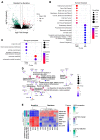Association of SLC12A1 and GLUR4 Ion Transporters with Neoadjuvant Chemoresistance in Luminal Locally Advanced Breast Cancer
- PMID: 38003293
- PMCID: PMC10670992
- DOI: 10.3390/ijms242216104
Association of SLC12A1 and GLUR4 Ion Transporters with Neoadjuvant Chemoresistance in Luminal Locally Advanced Breast Cancer
Abstract
Chemoresistance to standard neoadjuvant treatment commonly occurs in locally advanced breast cancer, particularly in the luminal subtype, which is hormone receptor-positive and represents the most common subtype of breast cancer associated with the worst outcomes. Identifying the genes associated with chemoresistance is crucial for understanding the underlying mechanisms and discovering effective treatments. In this study, we aimed to identify genes linked to neoadjuvant chemotherapy resistance in 62 retrospectively included patients with luminal breast cancer. Whole RNA sequencing of 12 patient biopsies revealed 269 differentially expressed genes in chemoresistant patients. We further validated eight highly correlated genes associated with resistance. Among these, solute carrier family 12 member 1 (SLC12A1) and glutamate ionotropic AMPA type subunit 4 (GRIA4), both implicated in ion transport, showed the strongest association with chemoresistance. Notably, SLC12A1 expression was downregulated, while protein levels of glutamate receptor 4 (GLUR4), encoded by GRIA4, were elevated in patients with a worse prognosis. Our results suggest a potential link between SLC12A1 gene expression and GLUR4 protein levels with chemoresistance in luminal breast cancer. In particular, GLUR4 protein could serve as a potential target for drug intervention to overcome chemoresistance.
Keywords: chemoresistance; ion transport; locally advanced; luminal breast cancer; neoadjuvant chemotherapy.
Conflict of interest statement
The authors declare no conflict of interest.
Figures




Similar articles
-
Fatty acid receptor GPR120 promotes breast cancer chemoresistance by upregulating ABC transporters expression and fatty acid synthesis.EBioMedicine. 2019 Feb;40:251-262. doi: 10.1016/j.ebiom.2018.12.037. Epub 2019 Feb 6. EBioMedicine. 2019. PMID: 30738829 Free PMC article.
-
Transcriptome Analysis Identifies GATA3-AS1 as a Long Noncoding RNA Associated with Resistance to Neoadjuvant Chemotherapy in Locally Advanced Breast Cancer Patients.J Mol Diagn. 2021 Oct;23(10):1306-1323. doi: 10.1016/j.jmoldx.2021.07.014. Epub 2021 Aug 4. J Mol Diagn. 2021. PMID: 34358678
-
Neoadjuvant Endocrine Therapy in Breast Cancer Upregulates the Cytotoxic Drug Pump ABCG2/BCRP, and May Lead to Resistance to Subsequent Chemotherapy.Clin Breast Cancer. 2018 Dec;18(6):481-488. doi: 10.1016/j.clbc.2018.07.002. Epub 2018 Jul 6. Clin Breast Cancer. 2018. PMID: 30055962
-
Overview of resistance to systemic therapy in patients with breast cancer.Adv Exp Med Biol. 2007;608:1-22. doi: 10.1007/978-0-387-74039-3_1. Adv Exp Med Biol. 2007. PMID: 17993229 Review.
-
[NEOADJUVANT TREATMENT OF LOCALLY ADVANCED ESTROGEN/PROGESTERONE POSITIVE, HER2NEU NEGATIVE BREAST CANCER].Harefuah. 2020 May;159(5):370-375. Harefuah. 2020. PMID: 32431130 Review. Hebrew.
Cited by
-
Cancer genomics and bioinformatics in Latin American countries: applications, challenges, and perspectives.Front Oncol. 2025 Jul 9;15:1584178. doi: 10.3389/fonc.2025.1584178. eCollection 2025. Front Oncol. 2025. PMID: 40703551 Free PMC article. Review.
References
-
- Cancer Today. [(accessed on 27 February 2023)]. Available online: https://gco.iarc.fr/today.
-
- Pinto J.A., Pinillos L., Villarreal-Garza C., Morante Z., Villarán M.V., Mejía G., Caglevic C., Aguilar A., Fajardo W., Usuga F., et al. Barriers in Latin America for the Management of Locally Advanced Breast Cancer. Ecancermedicalscience. 2019;13:897. doi: 10.3332/ecancer.2019.897. - DOI - PMC - PubMed
MeSH terms
Substances
Grants and funding
LinkOut - more resources
Full Text Sources
Medical
Molecular Biology Databases

